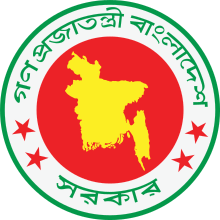Rangpur, Bangladesh
Rangpur (Bengali: রংপুর Raṃpur) is one of the major cities in Bangladesh and Rangpur Division. Rangpur was declared a district headquarters on 16 December 1769, and established as a municipality in 1869, making it one of the oldest municipalities in Bangladesh.[3][4] The municipal office building was erected in 1892 under the precedence Raja Janaki Ballav Sen. Chairman of the municipality. During the period of 1890, Shyamasundari canal was excavated for improvement of the town.
Rangpur City রংপুর | |
|---|---|
Metropolitan City | |
.jpg) 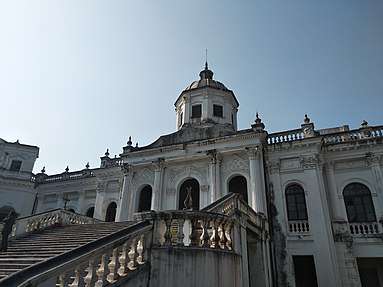 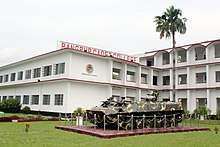  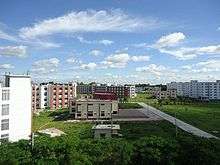 .jpg) From top: City at night, Tajhat Palace, Rangpur Cadet College, Chikli vata lake, Begum Rokeya University, Town Hall | |
| Nickname(s): Green city | |

Expandable map of Rangpur | |
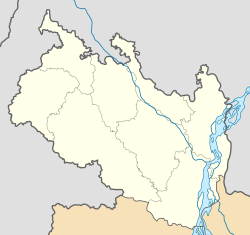 Rangpur City Location in Rangpur Division, Bangladesh 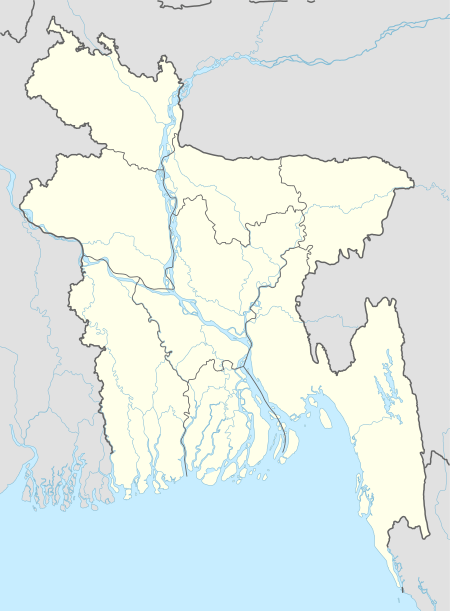 Rangpur City Location in Bangladesh | |
| Coordinates: 25.56°N 89.25°E | |
| Country | |
| Division | Rangpur Division |
| District | Rangpur District |
| Municipality | 1 May 1869 |
| City Corporation | 28 June 2012 |
| Metropolitan City | 16 September 2018 |
| Government | |
| • Type | Mayor–Council |
| • Body | Rangpur City Corporation |
| • City Mayor | Mostafizar Rahman Mostafa (Jatiya Party)[1] |
| Area | |
| • Urban | 207 km2 (80 sq mi) |
| • Metro | 239.72 km2 (92.56 sq mi) |
| Area rank | 3rd largest in Bangladesh |
| Elevation | 34 m (111.549 ft) |
| Population (2017) | |
| • Rank | 5th in Bangladesh |
| • Density rank | 5th in Bangladesh |
| • Urban | 796,556 |
| • Urban density | 3,871/km2 (10,030/sq mi) |
| • Metro | 1,000,000 |
| • Metro density | 4,167/km2 (10,790/sq mi) |
| Demonym(s) | Rangpuria/Rongpuria (রংপুরিয়া) |
| Time zone | UTC+6 (BST) |
| Postal code | 5400[2] |
| Police | Rangpur Metropolitan Police |
| Calling Code | 521 |
| Website | rpcc |
The Municipality is located in the north western part of Bangladesh.[3]Begum Rokeya University is situated in the southern part of the city. Previously, Rangpur was the headquarters of Greater Rangpur district. Later the Greater Rangpur district was broken down into the Rangpur, Kurigram, Nilphamari, Lalmonirhat and Gaibandha districts. In the great Rangpur region, little economic development took place until the 1990s, mainly because of the yearly flooding the region used to see before the building of the Teesta Barrage. Coal is found near this district. There is a large military cantonment in the town, along with a Ghagot park (under military surveillance), in addition to a Carmichael College in town.
History
Rangpur was conquered by the army of Raja Man Singh, a commander of the Mughal emperor, Akbar, in 1575, but it was not until 1686 that it was fully integrated into the Mughal Empire. Names of places like Mughalbasa (literal meaning being a locality of the Mughals), and Mughalhat (literal meaning a "local market" organised by the Mughals) bear testimony to the Mughal Association and past of Rangpur and its hinterland. Later on, Rangpur passed under the control of Sarker of Ghoraghat. During the period of the British East India Company, the Sannyasi Rebellion took place.[5] Rangapur Ghoraghat has been mentioned in the Riyaz-us-Salatin. During the early period of the company rule fakir-sannyasi resistance and peasant rebellion were held in Rangpur.
Geography
Rangpur town is the divisional headquarters. The soil composition is mainly alluvial soil (80%) of the Teesta River basin, and the remaining is barind soil. The temperature ranges from 32 degrees Celsius to 11 degrees Celsius, and the annual rainfall averages 2931 mm. Rangpur town, covering an area of around 28 square kilometres, lies on the bank of the Ghaghat river, and was turned into a municipality back in 1869. The population of the Rangpur City Corporation as of 2017 was 7,96,556 with 49% male and 51% female, and the literacy rate is 61%. Establishment of Rangpur City Corporation, as Divisional City is now under way after the establishment of Rangpur Division in January 2010.
Climate
Rangpur has a humid subtropical climate. The Köppen-Geiger climate classification is Cwa. The climate of Rangpur is generally marked with monsoons, high temperature, considerable humidity and heavy rainfall. The hot season commences early in April and continues till July. The average annual temperature in Rangpur is 24.9 °C (76.8 °F). About 2,192 mm (86.30 in) of precipitation falls annually.
| Climate data for Rangpur (1990-2019) | |||||||||||||
|---|---|---|---|---|---|---|---|---|---|---|---|---|---|
| Month | Jan | Feb | Mar | Apr | May | Jun | Jul | Aug | Sep | Oct | Nov | Dec | Year |
| Record high °C (°F) | 32 (90) |
35 (95) |
39 (102) |
42 (108) |
42 (108) |
42 (108) |
39 (102) |
38 (100) |
37 (99) |
36 (97) |
36 (97) |
33 (91) |
42 (108) |
| Average high °C (°F) | 24.4 (75.9) |
27.1 (80.8) |
31.5 (88.7) |
34.1 (93.4) |
32.6 (90.7) |
31.8 (89.2) |
31.7 (89.1) |
31.8 (89.2) |
31.8 (89.2) |
30.9 (87.6) |
28.4 (83.1) |
25.6 (78.1) |
30.1 (86.3) |
| Average low °C (°F) | 10.3 (50.5) |
12.0 (53.6) |
15.9 (60.6) |
21.0 (69.8) |
23.0 (73.4) |
24.7 (76.5) |
25.7 (78.3) |
26.3 (79.3) |
25.6 (78.1) |
22.3 (72.1) |
16.4 (61.5) |
12.2 (54.0) |
19.6 (67.3) |
| Record low °C (°F) | 3 (37) |
3 (37) |
5 (41) |
8 (46) |
15 (59) |
22 (72) |
23 (73) |
22 (72) |
19 (66) |
13 (55) |
6 (43) |
3 (37) |
3 (37) |
| Average precipitation mm (inches) | 9 (0.4) |
12 (0.5) |
26 (1.0) |
78 (3.1) |
291 (11.5) |
481 (18.9) |
461 (18.1) |
352 (13.9) |
315 (12.4) |
154 (6.1) |
10 (0.4) |
3 (0.1) |
2,192 (86.3) |
| Source: Climate-Data.org,Climate data, Microsoft Weather | |||||||||||||
Economy


The city is the commercial hub for the surrounding districts. The city centre has a number of government and private banks, insurance companies, residential hotels, Chinese and Indian restaurants, fast food, sweet shops, gift shop and many more. It is one of the most important economic zones in Bangladesh, because of its global positioning.
Places of interest

.jpg)
Tajhat Palace
Tajhat Palace is located at Tajhat, the southern end of Rangpur city. It was the earlier high court building established in 1984 called the Tajhat, a former zamindar's palace. After the end of the British Raj, the building was abandoned and decayed rapidly, although it was used for a few years as a courthouse during the 1980s. In 2004, it was largely restored and turned into a museum which hosts a collection of Blackstone Hindu carvings, calligraphic art from the Mughal period and other objets d'art and coins from the area on display. Due to lack of funding, the museum is sometimes closed.[6]
The place is situated three km on the south–east outskirts of the town of Rangpur. Probably this place was built by Maharaja Kumar Gopal Lal Ray in the beginning of the 20th century from 1984 to 1991. The palace was used as a Rangpur high Court branch of the Bangladesh Supreme court in 1995. The palace was declared as a Protected monument by the department of archaeology. recognising its outstanding archaeological value the government of Bangladesh decided to shift the Rangpur museum here in 2002. Accordingly, the palace in being partly used as Rangpur museum since 2005.
Carmichael College
Carmichael College is one of the old colleges in Bangladesh established in 1916. The main attraction of this college is its administrative building (which houses the Bangla department). The building was designed with an Indo-Saracenic Revival architecture. The college with lot of education departments like history, physical, English and more.
Begum Rokeya University
Town Hall
There is an ancient auditorium named 'Town Hall' at the center of the city, where different cultural programs are held. The place all local persons meet and spend time with friends and family.
Jadu Nibash
Located in Radhaballav next to the Rangpur Government College. Home of Late Mashiur Rahman Jadu Mia. It is an ancient house, about a hundred years old. The house was probably built and owned by Raja Gopal Lal Rai Bahadur at the same time that the Rangpur District Council, Rangpur Town Hall and the famous Tajhat Palace buildings were built.
Zoo
Rangpur central zoo is one of the main amusement and recreation spot of Rangpur city. With an area of 20.27 acre of lush green trees and grasses, the Rangpur zoo is located east side of Hanuman-tola road beside police-line, not far from Rangpur district Administration office. The Zoo has 193 individual animals of 28 species.[7] Many wild animals are available to attract the visitors. A few of them are The Bengal tiger, African lion, Leopard, Asiatic black bear,Hippopotamus, Peacocks, crocodiles, Turtles, Spotted Deer, different kinds of Birds, Snakes and so on.
The Rangpur zoo was built in the 1880s. Bangladesh University of Engineering and Technology (BUET) completed a digital survey and feasibility study of "Dhaka And Rangpur Zoo Modernization Project" to upgrade the facilities to international standard.[8][9][10]
Vinno Jogot
"Vinno Jogot" (meaning Different World) is a well decorated amusement park, which is located about 12-kilometer distance from Rangpur city. Thousands of people come every day for refreshment with a green environment. A vast lake surrounded across the park. A planetarium has existed there. Shisu park, various ride, mural of world's seven wonders charm tourists.
Chikli Binodon Park
Kellaband Mosque (Masjid)
Kellaband Mosque is situated at C.O. Bazar on the north of Rangpur-Dinajpur Highway 02 km north-west of Rangpur town. This three-dome mosque is about 200 years old. A concrete well and an ancient cemetery are lying beside the mosque.
Pirgachha Landlord House
The Manthana Kingdom Estate was established sometime around 1100 AD. Maharani Joy Durga Devi Chaudhurani of Rangpur was the most influential and famous ruler of the kingdom. After the death of Rajah Rajendra Narayan Roy Choudhury, the Monthana Kingdom Estate was divided into two parts among his two sons Rajah Harendra Narayan Roy Choudhury and Rajah Bhairab Narayan Roy Choudhury of Rangpur. As a result, the landlord house also divided into two parts. After the death of Rajah Harendra Narayan Roy Choudhury his son Rajah Mahendra Narayan Roy Choudhury succeeded the kingdom. After his death, Rajah Bhupendra Narayan Roy Choudhury succeeded to the throne of the kingdom and was the last crowned king of this kingdom estate. His son Prince Jyotirindra Narayan Roy Choudhury was born in 1947 and is the crown prince of the estate. Soon after the birth of Jyotirindra Narayan Roy Choudhury, India and East Bengal got independence from colonialist British rule and the partition of historic Bengal took place. Prince Jyotirindra Narayan Roy Choudhury of Rangpur now resides in Calcutta, India, with his family. His son Prince Rupendra Narayan Anirban Roy Choudhury of Rangpur who uses the name Anirban Roy Choudhury is the present Titular Crown Prince of the kingdom-estate. The Pirgaccha Landlord House popularly known as the Manthana Palace or Manthana Rajbari is a massive structure spread over hundreds of acres of land and houses ponds, lakes, buildings, temples, and various other assets. Princess Kabita Rani Roy Choudhury is the present legal owner of the entire kingdom-estate. The Kachari House of the Manthana Palace is now used as Pirgasha Registrar Office.
Devi Chaudhuranir Jamindar Bari
The Landlord-King of Pirgacha sub district Rajah Narendro Narayan Roy Choudhury, son of Rajah Raghabendra Narayan Roy Choudhury died in 1765 without any legacy. Then the wife of the late King, Maharani Joy Durga Devi Chaudhurani of Rangpur managed the kingdom for three decades. Maharani Joy Durga Devi Chaudhurani is popularly known as Devi Chaudhurani in history and was one of the most successful and popularly known rulers of the kingdom. During the time of Sanyasi Bidroho (ascetic revolution) for the independence of India, she along with Bhabani Pathak raged war against the British. In this insurgency Collector Richard Gudland and army commander Lieutenant Brenan, scared of the war situation, forfeited the kingdom from Devi Chaudhurani. However the imperial British could not keep the kingdom forfeited from the illustrious Maharani, and soon after she again came to manage the kingdom and she ruled until 1791. Later in history, the famous Bengali novelist, Bankim Chandra Chattopadhyay, who also happened to be the Collector of Rangpur and under the employment of the British rule, wrote the famous novel Devi Chaudhurani to portray her as a dacoit-queen. The novel has been adapted into very famous movies with the 1974 movie starring Suchitra Sen in the lead. And National Award winning director Rituporno Ghosh is adapting the novel into another movie in recent times, in which Aishwarya Rai Bachchan will play the lead role of Devi Chaudhurani. However, the novel has tarnished the character and image of Maharani Joy Durga Devi Chaudhurani to a great extent. Rajah Bhupendra Narayan Roy Choudhury of Rangpur was the last king of the kingdom-estate. An earthquake damaged much of the palace built by Devi Chaudhurani. However, the palace was rebuilt several times and is a sprawling structure spread over several hundreds of acres. The property, land and the assets of the estate kingdom is presently legally owned by Princess Kabita Rani Roy Choudhury of Rangpur, who lives in Kolkata, India. Her son Prince Rupendra Narayan Anirban Roy Choudhury of Rangpur who commonly uses the name Anirban Roy Choudhury is the present Titular Crown Prince of the estate-kingdom. Prince Anirban Roy Choudhury is currently studying the law at Symbiosis Law School and lives in Pune, Mumbai, New Delhi and Kolkata.
Itakumari Jamindar Bari
Itakumari Landlord house was established in the 19th century. Shibchondro elder son of landlord Rajarai was the founder of Itakhula Landlord house. Now most of the building are ruined . Now a well two large pond and elderly building witness of time. Again Shibchanda and Devi Chowdhurani lead the public rebellion and free the people of Rangpur from Devi singha's torture.
Deowan Bari Jamindaar Bari
The Deowan Bari Jamindaar Bari was built by Fonivuson Mojumdar. Fonivuson Mijumdar was the son of Landlord Radharomon and mother Kusum Kumari Devi who was the second wife of Radharomon. He was born in 1892. This landlord house is a small 2 storied building. but the main gate of the house is like a Mughal Castle – gate. After ban of the Real estate tenancy practices in 1952 the house was auctioned. The property was purchased by one Nosor Ghatial who hailed from Kurigram. Now there is a school and some business centres. It is located at Deowan Bari road in Rangpur near the town.
Pirgachha[11]
Pirgachha is one of the Upazilas in Rangpur that carries some interesting aspects. The name is derived from some unknown "pir"(religious guru), buried under a tree("gach"). In other words, there was this tomb of a "pir" under a big tree in Pirgachha. Pirgachha has a Rajbari, home of the Jomider (barons, if you will, or landlords, appointed by the King at that times). This one historic residence is now almost ruined. Also, there is a miniature prayer place such as a mosque (for Muslim) and a Temple (for Hindu) built together. It shows a friendly Hindu-Muslim communities.
Chicli vata

Near the stadium, there is a place called 'Chicli vata' surrounding by many lakes and rice fields.
Other Places
There is a large military cantonment in the town. Apart from the Tajhat museum, there is another museum at the heart of the town. The town is known as Green Town for its gardens and green parks throughout the town.
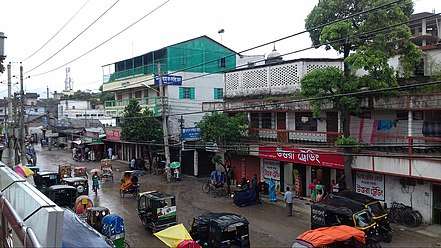
Education


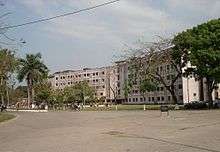


Major educational institutes in the city including:
Universities:
- Begum Rokeya University
- Rangpur City MATS and IHT, Rangpur
Medical & Dental Colleges:
- Rangpur Medical College
- Prime Medical College
- Rangpur Community Medical College
- Northern Private Medical College.
- Rangpur Army Medical College
- Kasir Uddin Memorial Medical College
- Rangpur Dental College
- Rangpur City MATS and IHT, Rangpur
Polytechnic Institutes:
Colleges:
- Begum Rokeya College
- Carmichael College[12]
- Rangpur City MATS and IHT, Rangpur
- Colectorate School and College
- Carmichael Collegiate School and College
- Rangpur Model College
- Police Lines School and College
- Rangpur Cadet College
- Cantonment Public School And College, Rangpur
- Rangpur Technical School And College
- Rangpur Government College
- RCCI Public School & College
- Lions School & College
- The Millennium Stars School & College
- Somaj Kolyan Women School & College
- Residential Model School and College
- Mahigong College
- Rangpur Public School & College
- Uttom College
- Rangpur City College
- Robertsonganj High School & College
- Robertsonganj Girls' High School & College
- Siddique Memorial School & College
- Dhap Lalkuthi High School & College
Affiliated Colleges:
- International Institute of Applied Science and Technology, Rangpur
Schools:
- Cantonment Public School And College, Rangpur
- Rangpur Zilla School
- Rangpur Govt. Girls' High School
- Govt. Commercial Institute
- Bir Uttam Shaheed Samad High School
- Rangpur High School
- Salma Girls High School
- Afanullah High School, Alamnagar
- Adasha High School, Babukha
- Shalbon Pauro Girls High School
- Tajhat High School
English Medium School:
- The Millennium Stars School & College
- Shahan International School
- Nalanda International School
- International Grammar School
- BIAM Laboratory School
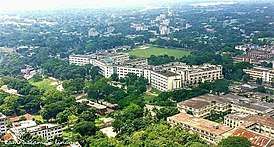
Healthcare
Rangpur is well known for its healthcare facilities throughout the north-Bengal districts. There are hundreds of hospitals, private clinics, diagnostic centres situated all over the city. The Rangpur Medical College Hospital (RMCH), a tertiary level thousand bed facility public hospital with teaching facility in graduate and post graduate medical education. The campus of Rangpur Medical College is located in the northwest area of Rangpur. It is 210 kilometres from the Rajshahi District and 330 kilometres from Dhaka and is located next to the inter-country highway that connects India to Nepal. Prime Medical College hospital (750 beds), Doctor's Community Hospital (500 beds), Northern Private Medical College Hospital, Christian missionary hospital are the well-known private institutes. Other government institutes include a children hospital, a chest hospital and an infectious disease hospital.
A 1000 bed-hospital known as Health City is under construction aiming to provide medical treatments and surgeries.
Media
Newspaper
There are a number of locally published newspapers in the district. Locally published newspapers and periodicals include Online News Portal BNN (Bangladesh National News) (2016), Rangpur Onlinelivenews24 (2012), Desh71 (2012), Crime News (2005), Daily Rangpur Chitra (2009), Daily Akhira (1990) Dabanal (1980), Rangaprovat (1987), Juger Alo (1992), Dainik Paribesh (1994),Daily Gonoalo (2012) Dainik Rangpur (1997), Weekly Atal (1991), Rangpur Barta (1996) and Weekly Bajrakantha (Pirganj). Former newspapers which are no longer published include Rangapur Bartabaha (1847), Rangapur Dik Prakash (1861), Rangapur Darpan (1907), Uttar Bangla (1960) and Pravati (1955).[13]
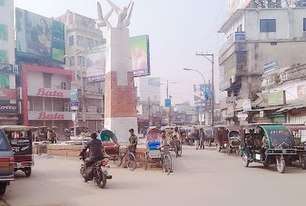
Transportation
The main transport systems used in the city are cycle rickshaws, auto rickshaws (mainly known as baby-taxis or CNGs), buses, mini-buses and cars. There are about 50,000 rickshaws running each day.
Roads
Rangpur is well connected by highways to Chittagong and Dhaka, as well as other parts of Rangpur. It takes about 6 to 7 hours by road to reach the capital Dhaka by National Highway 5. Bus services to other major districts are also available from Rangpur. Highway links to India have been established through the Asian Highway 2.
Railway
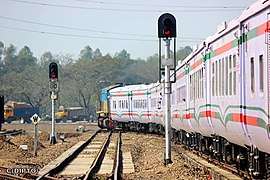
The Rangpur Railway Station is the main railway station providing trains on national routes operated by the state-run Bangladesh Railway. The Rangpur Express is a Bangladeshi Intercity train which runs between Rangpur and Dhaka.
Air
The city of Rangpur is served by Saidpur Airport, located at the north of the city. Saidpur airport is a domestic airport. Saidpur Airport is connected through several private airlines such as Novoair, US-Bangla Airlines, Regent Airways & Biman Bangladesh Airlines a government airline with Capital city of Bangladesh Dhaka.
Dialect
Many Rangpur natives speak Rangpuri language. Rangpuri is an Indic language spoken by half a million Rajbongshi people in Bangladesh and five million in India, where they are known as Rajbanshi. Many are bilingual in either Bengali or Assamese. Rangpuri goes by numerous names. In Bangladesh, these include Rangpuri, Bahe Bangla, Anchalit Bangla, Kamta, Polia. The main dialects are Western Rajbanshi, Central Rajbanshi, Eastern Rajbanshi and Hill Rajbanshi (also known as Koch language).
Sports
The most popular sport in Rangpur is cricket, although football is also popular. There is a 10,000+ capacity stadium in the city. It is known as Rangpur Stadium. It is used for football and other sports. Besides different organisation share to stage a show there occasionally. There are another ground known as Cricket Garden[14] and is mainly used for cricket. There are also a few sports training academies in the city. In domestic Twenty20 cricket, Rangpur has a Bangladesh Premier League franchise known as Rangpur Riders. On December 2012, I Sports bought the Rangpur franchise for $1.01 m. Notable players from Rangpur who have played for the national team include Nasir Hossain,[15] Suhrawadi Shuvo.[16]
Notable people
- Annette Beveridge, British Indologist, known works being the translations of the Baburnama[17] from the Turki (Turkish) language, and the Humayun-nama from Persian.[18][19]
- William Beveridge, British economist who wrote the Beveridge Report that influenced United Kingdom to implement welfare state policies after World War II.
- Begum Rokeya Shakhawat Hossain, who was most famous for her efforts on behalf of gender equality and other social issues.
- Mashiur Rahman Jadu Mia (Politician, Founding member of BNP and Senior Minister with the rank of a Prime Minister in 1979).
- Abu Sadat Mohammad Sayem, 6th President of Bangladesh, first chief justice of Bangladesh.
- Hussain Muhammad Ershad, former President of Bangladesh.
- Anisul Hoque, author, novelist, dramatist, and journalist.
- M. A. Wazed Miah reputed Bangladeshi nuclear scientist who was former Chairman of the Bangladesh Atomic Energy Commission. He is the husband of Prime Minister Sheikh Hasina Wazed.
- Nasir Hossain, prominent Bangladeshi all-round cricketer.
- Rezwana Choudhury Bannya, a Rabindra Sangeet artist.
- Dr. Rashid Askari, Writer, columnist, academic and the current vice-chancellor of Islamic University, Bangladesh.
- General Mustafizur Rahman, Former Chief of Army Staff of the Bangladesh Army.
- Mostafa Kamal, Chief Justice of Bangladesh.
- Sharif Imam, husband of Shahid janoni jahanara Imam
- Jahanara Imam, Bangladeshi writer and political activist.
- Abbasuddin Ahmed, Prominent Bhawaiya singer
- Rathindranath Roy, Founder of Bhawaiya academy and singer.
- Ferdausi Rahman, legendary folk singer.
- Hassan Mahmood Khandker, He is a Bangladeshi former Inspector General of Bangladesh Police
- Dipankar Dipon, Bangladeshi film director and screenwriter who predominantly works in Dhallywood.
- Akbar ali, Bangladeshi Cricketer.
Sister cities and twin towns
Rangpur twinned with:
|
|---|
Gallery
- Tajhat Palace.
 Shapla Chottor.
Shapla Chottor.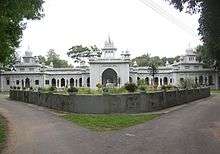 Zilla Porishod Building.
Zilla Porishod Building. Parjatan Motel.
Parjatan Motel..jpg) Terminal Mosque (Masjid).
Terminal Mosque (Masjid). Rangpur Modern.
Rangpur Modern. Begum Rokeya Memorial Centre.
Begum Rokeya Memorial Centre.- Jadu Nibash - an ancient house
 Ekattorer Boddho Bhumi - Memorial of Town Hall Massacre during 1971
Ekattorer Boddho Bhumi - Memorial of Town Hall Massacre during 1971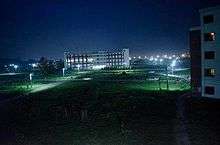 Begum Rokeya University at night
Begum Rokeya University at night
References
- "নতুন মেয়র বললেন রংপুর বদলে যাবে | কালের কণ্ঠ". Kalerkantho.
- "ZIP Code database of Bangladesh, Rangpur, Rangpur, Rangpur Sadar". Geopostcodes.com. Retrieved 11 June 2013.
- "Journey to Rangpur City Corporation". Archived from the original on 17 June 2015. Retrieved 17 June 2015.
- "Rangpur". britannica. Archived from the original on 17 June 2015. Retrieved 17 June 2015.
- Lorenzen, David N. (January–March 1978). "Warrior Ascetics in Indian History". Journal of the American Oriental Society. 98 (1): 61–75. doi:10.2307/600151. JSTOR 600151.
- Muhammad Moniruzzaman (2012), "Ray, Gopal Lal", in Sirajul Islam; Ahmed A. Jamal (eds.), Banglapedia: National Encyclopedia of Bangladesh (Second ed.), Asiatic Society of Bangladesh, archived from the original on 17 June 2015, retrieved 17 June 2015
- Rahman, Nargis Sultana ; Md. Mustafizur (2013). Present Status of Animals and Management of Rangpur Zoo (1. Aufl. ed.). Saarbrücken: LAP LAMBERT Academic Publishing. ISBN 978-3-659-48117-8. Retrieved 28 August 2014.
- "BUET suggests plan to raise zoo standard". New Age. Dhaka. Archived from the original on 28 August 2014. Retrieved 28 August 2014.
- "Dhaka zoo gets some new inmates". Daily Sun. Dhaka. Retrieved 28 August 2014.
- "Zoo modernisation still a far cry". Dhaka Tribune. Retrieved 28 August 2014.
- "Pirgachha Upazila". Pirgachha Upazila. Retrieved 17 April 2020.
- Muhammad Maniruzzaman (2012). "Carmichael College, Rangpur". In Sirajul Islam; Ahmed A. Jamal (eds.). Banglapedia: National Encyclopedia of Bangladesh (Second ed.). Asiatic Society of Bangladesh. Archived from the original on 17 June 2015. Retrieved 17 June 2015.
- "পত্র পত্রিকা সমূহ" [Newspapers] (in Bengali). Retrieved 17 June 2015.
- Cricket Garden, Rangpur, CricketArchive.com Retrieved on 29 July 2010.
- Players and Officials – Nasir Hossain Cricinfo.
- Players and Officials – Suhrawadi Shuvo Cricinfo.
- Babur (1922). Beveridge, Annette Susannah (ed.). The Babur-nama in English (Memoirs of Babur). London: Luzac and Co. Retrieved 14 December 2017.
- Beveridge, Annette Susannah (1898). Life and writings of Gulbadan Begam (Lady Rosebody). Calcutta. Retrieved 14 December 2017.
- Begam, Gulbaden (1902). Beveridge, Annette Susannah (ed.). The history of Humāyūn (Humāyūn-nāma). London: Royal Asiatic Society. Retrieved 14 December 2017.
- "Sister cities of Rangpur City — sistercity.info". en.sistercity.info. Retrieved 11 June 2020.
- "Sister cities of Rangpur City — sistercity.info". en.sistercity.info. Retrieved 11 June 2020.
- "Sister cities of Rangpur City — sistercity.info". en.sistercity.info. Retrieved 11 June 2020.
External links
| Wikimedia Commons has media related to Rangpur. |
| Wikisource has the text of the 1911 Encyclopædia Britannica article Rangpur. |
- Rangpur City Corporation
- Rangpur oriented website
- Abdus Sattar (2012). "Rangpur District". In Sirajul Islam; Ahmed A. Jamal (eds.). Banglapedia: National Encyclopedia of Bangladesh (Second ed.). Asiatic Society of Bangladesh. Retrieved 13 May 2016.
- Population and Housing Census 2011 - Volume 3: Urban Area Report (PDF), Bangladesh Bureau of Statistics, August 2014
